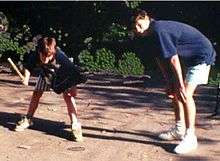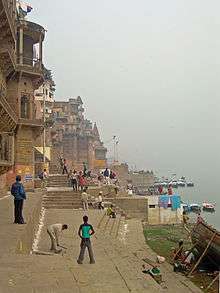Gilli-danda
Gilli-Danda is an amateur sport played in the rural areas and small towns all over Bangladesh, India, Nepal, Afghanistan and Pakistan as well as Cambodia, Turkey and Italy. The game is played with two sticks: a large one called a danda, which is used to hit a smaller one, the gilli.[1]
Gilli Danda is an ancient sport of India, possibly with origins over 2500 years ago.[2][3] It is believed to be the origin of Western games such as cricket, baseball and softball.
ghaṭikā [ghaṭ a+ka] – This term is translated as "tip-cat". An explanatory definition is given in the commentary as, ghaṭikā is "a game played using two sticks: one long and the other short. It is played by hitting the shorter stick with the longer one." Ghaṭikā is still known to South Asian countries, like Bangladesh, India, Sri Lanka etc. In Bangladesh it is known as ḍāṅguli khelā. The longer stick in a ḍāṅguli khelā, should be about 1½ ft and the shorter stick about 6 inches. There are certain rules for preparing the sticks and playing the game with them. [4]
Names
Gilli Danda is known by various other names: it is called Tipcat in English, Itti Dakar in Sindhi, Dandi-Biyo (डण्डी बियो) in Nepali, guli-badi (ଗୁଲି ବାଡ଼ି) in Odia (regional variations dabalapua ଡାବଲପୁଆ and ପିଲବାଡ଼ି pilabadi in Phulbani and guti-dabula ଗୁଟିଡାବୁଳ in Balasore) alak-doulak (الک دولک) in Persian, dānggűli (ডাঙ্গুলি) in Bengali & Assamese, chinni-dandu in Kannada, kuttiyum kolum in Malayalam, viti-dandu विट्टी दांडू in Marathi,Koyando-bal(कोयंडो बाल) in Konkani, kitti-pul (கிட்டி-புல்) in Tamil, Gooti-Billa or Karra-Billa or Billam-Godu or chirra-gonay (in Telangana) in Telugu, Gulli-Danda (ਗੁੱਲ਼ੀ ਡੰਡਾ) in Punjabi, Geeti Danna (گیٹی ڈنا) in Saraiki, Iti-Dakar (اٽي ڏڪر) in Sindhi, Lappa-Duggi (لپا ڈگی) in Pashto, Kon ko in Cambodian, Pathel Lele in Indonesian, syatong in Tagalog, awe petew in Ilonggo, çelikçomak in Turkish and ciang sat in Zomi langauge.
Rules

"Gilli Danda" is played with two pieces of equipment - a danda, being a long wooden stick, and a gilli, a small oval-shaped piece of wood.
Standing in a small circle, the player balances the gilli on a stone in an inclined manner (somewhat like a see-saw) with one end of the gilli touching the ground while the other end is in the air. The player then uses the danda to hit the gilli at the raised end, which flips it into the air. While it is in the air, the player strikes the gilli, hitting it as far as possible. Having struck the gilli, the player is required to run and touch a pre-agreed point outside the circle before the gilli is retrieved by an opponent. There are no specific dimensions of gilli danda and it does not have limited number of players.
The gilli becomes airborne after it is struck. If a fielder from the opposing team catches the gilli, the striker is out. If the gilli lands on the ground, the fielder closest to the gilli has one chance to hit the danda (which has to be placed on top of the circle used) with a throw (similar to a run out in cricket). If the fielder is successful, the striker is out; if not, the striker scores one point and gets another opportunity to strike. The team (or individual) with the most points wins the game. If the striker fails to hit the gilli in three tries, the striker is out (similar to a strikeout in baseball). After the gilli has been struck, the opposing players need to return to the circle or, in the best case, catch it in mid-air without its hitting the ground - this was believed to have later evolved into a Catch Out in cricket and baseball.
Variations
As an amateur youth sport, gilli-danda has many regional variations. In some versions, the number of points a striker scores depends on the distance the gilli falls from the striking point. The distance is measured in terms of the length of the danda, or in some cases the length of the gilli. Scoring also depends on how many times the gilli was hit in the air in one strike. If it travels a certain distance with two mid-air strikes, the total points are doubled.If the gilli is not struck far enough the player has to pick it up and try again.
Similar games
- In Azerbaijan, a similar game is called Çilingağac (Chilingaghaj).
- In Galicia, a similar game is called bilharda.
- In Catalonia and the Valencian Community, a similar game is called bòlit.
- Philippines, a game known as syatong or pati-kubra (in Morong, Rizal is similar to gilli-danda.
- In Italy a similar game known as "Lippa", "Lipe", "Tirolo", or "S-cianco" is shown in the movie Watch Out, We're Mad!.[5][6][7]
- In the United States, a similar game is called pee-wee.[8]
- Dainty is a street ball game played in Schnitzelburg, Louisville, in the United States
- In England, a similar game was called Tip-cat, giddy-gaddy and cat's pallet.
- In Poland a similar game is known, called Klipa
- In Malaysia a similar game is known as konda kondi
- In Russia a similar game is known as chizhik (чижик)
- In Slovenia a similar game is known as pandolo
In popular culture
In 2014 Vitti Dandu a sport-drama Marathi movie was made on the same sport produced by Ajay Devgan and Leena Deore.
The Bollywood movie Lagaan mentions the traditional youth sport of gilli-danda as being similar to cricket.
The Hindi writer Premchand wrote a short story named "Gilli-danda" in which he compares old simple times and emotions to modern values and also hints at caste inequalities in India. The protagonist and narrator of the story recounts his inability to play gilli-danda well in his youth. He remembers a friend who could literally control the gilli as he wished. He goes away and comes back as an adult and a government officer. He searches for his old friend and finds him - he is very poor and says "Where do we get the time?" when asked by the protagonist whether he plays gilli-danda. The protagonist convinces him to play - he cheats at every opportunity, but his friend meekly submits, even though he would not have let him get away with such deceit in his youth. After being defeated, the friend invites him to a gilli-danda match the next day. The protagonist is shocked when he sees his friend play just as well as before and realises that he had indulged him because he knew that he had forgotten the basics of gilli-danda. The protagonist feels very small and goes back to the city humiliated.[9]
See also
- Backyard cricket
- Pittu Garam, also known as Pithu Fod or simply Pithu
- Kho Kho
- Paandi
References
- ↑ http://www.indiamapped.com/sports-in-india/gilli-danda/
- ↑ Steve Craig (2002), Sports and Games of the Ancients: (Sports and Games Through History), ISBN 978-0313316005, pages 63-65
- ↑ John Arlott (1975), The Oxford Companion to World Sports and Games, Oxford University Press, ISBN 978-0192115386
- ↑ SEVEN GAMES OF INDIA IN THE 6TH CENTURY B.C. AS DEPICTED IN THE MAHĀTAṆHᾹSAṄKHAYASUTTA OF THE MAJJHIMANIKĀYA
- ↑ Bud Spencer, Terence Hill e a Billarda
- ↑ Y si no, nos enfadamos ( 2/10 ) - Juntos son dinamita
- ↑ palio mazza e pivezo cesa (CE)
- ↑ Frederic Gomes Cassidy, Joan Houston Hall (2002). Dictionary of American Regional English. Belknap, Harvard University Press. Retrieved 2011-09-14.
- ↑ Prakash Chandra Gupta (1998). Makers of Indian Literature: Premchand. Sahitya Akademi, New Delhi. Retrieved 2011-09-24.
External links
- How to Play Gilli-Danda
- SEVEN GAMES OF INDIA IN THE 6TH CENTURY B.C.
- Watch Gilli-danda being played
- Watch a Gilli-danda tournament
- Lippa (Italian)
- S-cianco (Italian)
